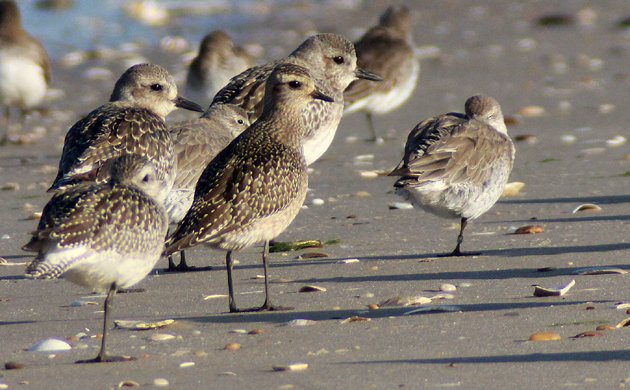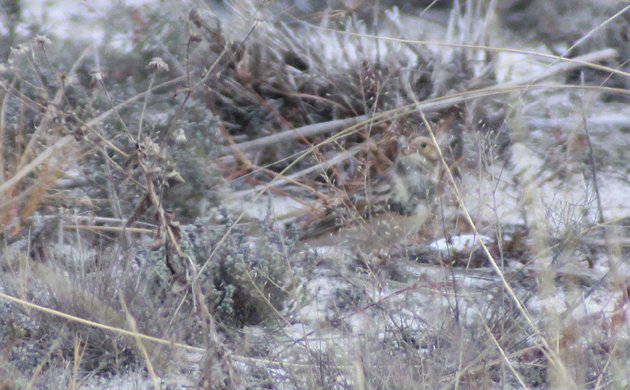
While at Jones Beach State Park on Saturday, co-leading the digiscoping field trip (with Clay Taylor from Swarovski Optik), I had a couple of experiences that made me wonder exactly how it is that birders find birds. Why, when a group of birders stare through a scope at the same flock of birds, does one birder find the different bird before the other birders? Why, when a group of birders are all searching some habitat for a previously-reported bird, does one birder refind the bird before the others?
Is it dumb luck? Is it innate skill? Is it patience and perseverance? I don’t pretend to have the answers but I hope some folks are willing to engage this topic in the comments. But, first, let me lay out the two scenarios that made my mind start mulling things over.
The first was when we were in the digiscoping trip proper. There were roughly ten of us practicing digiscoping at the famed sand bar near the Jones Beach Coast Guard Station. The bar was covered with shorebirds, gulls, geese, and cormorants. Suddenly, one of the participants, a relatively new birder named Lisa Scheppke, asked about a plover that she thought was different. She gave me a peak through her scope and, sure enough, the bird was different.
Of course, you expert birders reading this blog know why the other field trip at Jones Beach made their way over to the bar after they learned of Lisa’s discovery.
After a host of other birders arrived and everyone was enjoying good looks at Lisa’s American Golden-Plover a pigeon flew over the shorebirds and they must have mistaken it for a falcon because they all took wing as one before circling back to the bar. Of course, that meant the race was on to find the golden-plover again. This time, the first to find it was Tom Burke, one of New York State’s top birders both in terms of skill and list-size. Why was it found by a relative novice the first time around and by a top birder the second? Is there a reason?
Once the digiscoping workshop had moved on to Cammann’s Pond Park, where we had a good time digiscoping some cooperative waterfowl, herons, and kingfishers, I received a call from Tom letting me know that he and Gail Benson, another amazing New York birder, had found some Vesper Sparrows at the Theodore Roosevelt Nature Center. Seeing as the digiscoping trip was wrapping up, some of us decided to head over to check out the sparrows. We arrived at the boardwalk to not only be greeted by a big crowd of birders but also to learn that a Lapland Longspur was also hiding in the dune vegetation, but being very uncooperative. For some birders, it represented a life bird, so tension was high as those who would spot the longspur would try to direct others to it as it moved behind clumps of beach grass and past stands of goldenrod.
Most would get on the bird but some would not. Take a look at the shot at the top of this page to see if you can find it. Mind you, that is digiscoped and the shot is cropped very little, so that is roughly what I was seeing through my scope as I tried to get on the bird. Not easy, right? I’ve cropped the shot much more in the example below. That was one tough Lapland Longspur to see!
Yeah, I know it isn’t focused terribly well but this bird was a real skulker. This was the most open look that I got!
What separated those who saw the bird from those who didn’t? The people who saw the bird stayed focused on finding the bird. They asked, over and over again, who currently had the bird in sight and for directions to where the bird was. They were people who were willing to try to decipher directions like “Do you see the goldenrod with four stems going all different directions that is about one field left of the big tuft of beach grass that is just left of the goldenrod with the orange leaves? Yeah, it’s somewhere in the brown stuff to the left of that.”
People who got on the bird were also people who used their optics like they meant it. If binoculars had holsters they would be twirling their bins on their fingers and holstering them without looking. They didn’t need an explanation of the bird’s field marks because they already knew, at least roughly, what a Lapland Longspur should look like, even if they had never seen one before. These were birders who were prepared.
What’s the point of all of this? Basically, I think that if you want to be a good birder you have to practice. You have to study. You have to bird. A lot. But even that isn’t enough. You also have to be willing to keep looking even when there isn’t something “good” jumping out at you. When Lisa found that golden-plover on the sand bar we had all, collectively, gone through those birds probably five times. Was it there the whole time hidden behind another bird? Was it out in the open the whole time? Did it fly in unobserved? It doesn’t matter. What matters is that Lisa kept birding and found a good bird. Soon she’ll be picking out Lapland Longspurs as they fly overhead by their chip notes.
Anyway, sorry to ramble on and on about and then come to a really obvious conclusion. Go birding. Go birding some more. Stare at the birds until your eyes bleed. And don’t be a jerk to new birders – they’ll be finding rarities in no time and you’ll want to have your name on their list of contacts…















I started blogging in August and my next post this coming week was going to be about Persistence – The 60 Minute Rule. In a nutshell I have observed that better birders keep scanning an area or a flock until they are completely satisfied that there isn’t anything else there. For me, especially at waterfowl/shorebird areas, it seems that if I stay 60 minutes I have the best shot to see that bird that was hiding in the flock or just flew in. Why 60 minutes? Maybe because we do so many things for that length of time that we start to get restless if we go much longer. And I also have found it is much easier to do the 60 minutes when I am alone and there aren’t others wanting to move on. Not sure but Lisa probably found it because she persisted when others didn’t.
Anyway, I came across this discussion several years ago when I started to wonder why the same people kept finding rarities.
http://www.surfbirds.com/forum/showthread.php?4333-Finding-Rarities-I-need-help/page4